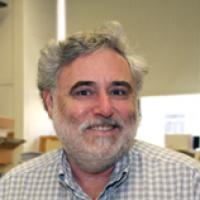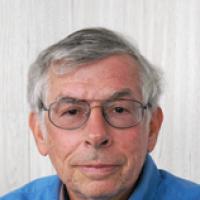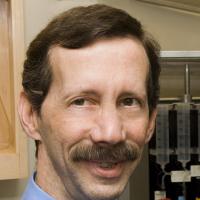Faculty Emeriti
Gerald D. Fischbach, M.D.
- Emeriti
Research
Throughout my career, I have studied the formation and maintenance of synapses, the junctions between nerve cells and their targets through which information is transferred. I have been particularly interested in the neuromuscular junction, a synapse that is easily accessible to experimental manipulation. I've pioneered the use of cultured neurons and muscle cells to characterize the biochemical, cellular, and electrophysiological mechanisms underlying development and function of the neuromuscular junction. Beginning in the 1970's, I embarked on a search for molecules released by motor neurons that regulate the number of acetylcholine receptors on muscle cells. This work culminated in 1993 with the purification and cloning of a protein called ARIA (for acetylcholine receptor-inducing activity) that stimulates synthesis of acetylcholine receptors by skeletal muscle cells. This molecule is now known to be a member of a family of trophic factors called neuregulins that are thought to be involved in a variety of important developmental processes in the nervous system. Because ARIA and other neuregulins act by binding to tyrosine kinase receptors on target cells, my work has been key in demonstrating that synaptic development relies upon biochemical mechanisms that are broadly similar to those that underlie the action of nerve growth factor and other well known trophic molecules. My current focus is on trophic factors that influence synaptic efficacy and nerve cell survival.
Selected Publications
1. Loeb JA, Hmadcha A, Fischbach GD, Land SJ, and Zakarian VL (2002). Neuregullin expression at neuromuscular synapses is modulated by synaptic activity and neurotrophic factors. J. of Neurosci. 22(6).
2. Mann MA, Knipe DM, Fischbach GD, Fields BN (2002). Type 3 reovirus neuroinvation after intramuscular inoculation: direct invasion of nerve terminals and age-dependent pathogenesis. Virology Nov 25:303(2):222-31.
3. Jacobson C, Duggan D, and Fischbach G, (2004) Neuregulin induces the expression of transcription factors and myosin heavy chains typical of muscle spindles in cultured human muscle. PNAS 101(33): 12218-12223.
4. Fischbach G, and Fischbach R, (2004) Stem Cells: science, policy, and ethics. J. of Clinical Investigation 114(10): 1364-1370.
5. Fischbach RL, and Fischbach GD, (2005) The brain doesn't lie. Am J Bioeth Spring 5(2): 54-55.
6. Liu Y, Ford BD, Mann MA, and Fischbach GD, (2005) Neuregulin-1 increases the proliferation of neuronal progenitors from embryonic neural stem cells. Dev Biol Jul 15;283(2): 437-445.
Penelope A. Boyden, PhD
- Emerita and Special Lecturer
Current Research
Cardiac electrophysiology; mechanisms of arrhythmias in experimental and naturally occurring animal models of disease. Research in our laboratory is dedicated to determining the electrophysiological basis of abnormal heart rhythms (cardiac arrhythmias). In one set of projects we enzymatically isolate single cells from hearts that have become arrhythmic due to experimental myocardial infarction, or pacing induced atrial fibrillation. We examine the function of specific ionic currents, in particular the sodium and potassium currents in the diseased cells and how this might be altered by drugs. Recently we are examining how Na channels are replenished on the surface of cells that survive in the infarcted heart and form the substrate for reentrant arrhythmias.
In other groups of experiments we use single Purkinje cells from diseased hearts in order to determine how intracellular calcium homeostasis is altered in cells of hearts post myocardial infarction. In some studies we combine whole cell voltage clamp techniques with epifluorescent and Ca2+ imaging techniques. We have found examples of reverse excitation contraction coupling where cytosolic Ca2+ elicits nondriven electrical activity.
Selected Publications
- Dun W, Danilo P Jr, Curran J, Mohler PJ, Boyden PA. 2017. Microtubule Remodeling and Decreased Nav1.5 Expression in Myocytes from Epicardial Border Zone of the Infarcted Canine Heart (in press).
- Reher T, Wang Z, Hseuh C_H, Chang PC, Pan Z, Kumar M, Patel J, Tan J, Shen C, Chen Z, Fishbein MC, Rubart M, Boyden PA, Chen P-S. 2017. Small conductance calcium activated potassium current in Normal rabbit Purkinje Cells. J Am Heart Assoc 26(6).
- Boyden PA. Dun W, Robinson RB. 2016. Cardiac Purkinje fibers and Arrhythmias; The Gordon K Moe Award Lecture. Heart Rhythm.13(5):1172-81.
- Boyden PA, Dun W Stuyvers B. 2015. What is a Ca2+ wave? Is it like an Electrical Wave? Arrhythmia and Electrophysiology Reviews, Arrhythm Electrophysiol Rev. May;4(1):35-9.
- Dun W, Wright P, Danilo Peter Jr, Mohler PJ, Boyden PA. 2014. SAP 97 and Cortactin Remodeling in Arrhythmogenic Purkinje Cells. PLoS One. 9:e2014.
- Dun W, Lowe JS, Wright P, Hund TJ, Mohler PJ, Boyden PA. 2013. Ankyrin-G participates in INa remodeling in myocytes from the border zone of the infarcted heart. PLOS ONE. 14;8(10):e78087
- Liu N, Denegri M, Dun W, Protasi F, Boncompagni S, Protasi F, Volpe P, Napolitano C ,Boyden PA, Priori SG: 2013. Abnormal propagation of calcium waves and ultrastructural remodeling in recessive CPVT. Circ Res 5;113(2):142-52.
- Gudmundsson H, Hund TJ, Wright PJ, Kline CF, Snyder JS, Qian L, Koval OM, Cunha SR, George M, Rainey MA, Kashef FE, Dun W, Boyden PA, Anderson ME, Band H, Mohler PJ. 2010. EH Domain Proteins Regulate Cardiac Membrane Protein Targeting. Circ Res;107(1):84-95.
- Pallante BA, Giovannone S, Fang-Yu L, Zhang J, Liu N, Kang G, Dun W, Boyden PA, Fishman GI. 2010. Contactin-2 expression in the cardiac Purkinje fiber network.Circ Arrhythm Electrophysiol. 1;3(2):186-94.
- Hirose M, Stuyvers B, Dun W, ter Keurs HEDJ and PA Boyden. 2008. Function of Ca2+ release Channels in Purkinje cells that survive in the Infarcted Canine Heart; a Mechanism for triggered Ventricular beats. Circ: Arrhythmia and Electrophysiology 1: 387-395
- Baba S, Dun W, Cabo C, Boyden PA.2005. Remodeling in cells from different regions of the reentrant circuit during ventricular tachycardia. Circulation 112:2386-2396
- Stuyvers BD, Dun W, Matkovich S, Sorrentino V, Boyden PA, ter Keurs HEDJ.2005. Confocal Analysis of Ca2+ Sparks and Waves in Canine Purkinje Cells; A Triple Layered System of Activation. Circulation Research 97:35-43

Steven Feinmark, PhD
- Special Lecturer
Current Research
Arachidonic acid metabolism in inflammatory cells and the nervous system; synthesis, biological and pharmacological activities of leuotrienes and PAF Arachidonic acid is an essential fatty acid that is metabolized to diverse biologically active products. We study the lipoxygenase metabolites of arachidonate known as leukotrienes. The leukotrienes are important regulators of white blood cell function and therefore play a role in the inflammatory process. We previously demonstrated that leukotriene synthesis occurs through a cooperative interaction between white blood cells and the cells that line the inside of blood vessels, the endothelial cells. We have identified what appears to be a novel kinase that regulates one branch of this pathway. In proper balance, these interactions keep white blood cells from initiating an inflammatory reaction but after the appropriate biological signal, they may serve to amplify the response. We are using high-performance liquid chromatography, immunoassay and gas chromatography/mass spectrometry to measure the production of leukotrienes.
Our second area of interest relates to the role of lipids as signaling molecules in excitable cells. We have looked at the role of platelet-activating factor, a phospholipid made by white blood cells, as an initator of arrhythmias in isolated cardiac myocytes. A larger effort has focused on the synthesis and function of lipoxygenase products in the nervous system. As a model system, we are using the marine mollusk, Aplysia californica. Previously we identified 12-lipoxygenase products as second messengers in identified neurons. More recently, we have identified a new pathway initiated by the 8-lipoxygenase in this same tissue. This new pathway appears to be linked to an unusual, G-protein linked, nicotinic acetylcholine receptor. Continuing biochemical and parallel functional studies are in progress.
Selected Publications
- Plotnikov AN, Yu H, Geller JC, Gainullin RZ, Chandra P, Patberg KW, Friezema S, Danilo P Jr, Cohen IS, Feinmark SJ, Rosen MR. (2003) Role of L-type calcium channels in pacing-induced short-term and long-term cardiac memory in canine heart. Circulation 107:2844-9.
- Barbuti A, Ishii S, Shimizu T, Robinson RB, Feinmark SJ. (2002) Block of the background K(+) channel TASK-1 contributes to arrhythmogenic effects of platelet-activating factor. Am J Physiol Heart Circ Physiol. 282:H2024-30.
- Tieman TL, Steel DJ, Gor Y, Kehoe J, Schwartz JH, Feinmark SJ. (2001) A pertussis toxin-sensitive 8-lipoxygenase pathway is activated by a nicotinic acetylcholine receptor in aplysia neurons. J Neurophysiol. 85(5):2150-8.
- Rybina IV, Feinmark SJ. (1999) Alteration of human leukotriene A4 hydrolase activity after site-directed mutagenesis: serine-415 is a regulatory residue. Biochim Biophys Acta. 1438(2):199-203.
- Keramidas A. and Harrison N.L. (2010). The activation mechanism of α1β2γ2 and α3β3γ2 GABAA receptors. Journal of General Physiology, 135, 59-75.
- Rybina IV, Liu H, Gor Y, Feinmark SJ. (1997) Regulation of leukotriene A4 hydrolase activity in endothelial cells by phosphorylation. J Biol Chem. 272(50):31865-71.
- Anyukhovsky EP, Sosunov EA, Feinmark SJ, Rosen MR. (1997) Effects of quinidine on repolarization in canine epicardium, midmyocardium, and endocardium: II. In vivo study. Circulation 96(11):4019-26.

Daniel Goldberg, PhD
- Professor Emeritus of Pharmacology and Neuroscience and Special Lecturer
Research in my laboratory examined three aspects of cellular neurobiology: a) the trafficking of organelles within the axon (the major process of a neuron), b) events at the specialized ending of the axon allowing it to display directed growth during development or after injury and c) the formation of synapses by the axon during development and adult plasticity. The methodological emphasis was on the use of high resolution techniques of light microscopy on individual living neurons.
Currently, I continue to teach in the curriculum for medical and dental students and in the Graduate Program in Pharmacology and Molecular Signaling, focusing on autonomic drugs and the autonomic nervous system.
Awards
- Alfred P. Sloan Research Fellowship
- Irma T. Hirschl Career Scientist Award
- Charles W. Bohmfalk Award for Distinguished Contributions to Teaching
- Distinguished Lecturer of the Year
- Fundamentals Outstanding Teacher Award

Andrew Wit, PhD
- Emeritus and Special Lecturer
Andrew L. Wit, Ph.D. joined the Department of Pharmacology in 1971 and was Professor of Pharmacology from 1981 to 2011 when he became Emeritus Professor of Pharmacology and Special Lecturer. He continued to teach Pharmacology graduate and medical students for the subsequent 5 years. During his time on the faculty he was director of the Pharmacology Medical and Dental course for 25 years and chairman of the Institutional Review Board for Human Investigation for 8 years (2000-2008). He maintained an active research program focused on electrophysiological causes of myocardial infarction arrhythmias, supported by NIH grants. His laboratory discovered that chronic infarct arrhythmias arise in infarct border zone myocytes that survive coronary occlusion. These myocytes have become the target for clinical arrhythmia ablation. Since his retirement he has maintained research collaborations with Dr Edward Ciaccio in the division of Cardiology at Columbia and Dr Elad Anter at Beth Israel Hosipital in Boston. He has continuously published research articles with these scientists. In 2017 Dr Wit published a text book on cardiac arrhythmias titled Electrophysiological Foundations of Cardiac Arrhythmias, coauthored with Hein J Wellens M.D from the Netherlands and Mark E Josephson M.D. from Harvard. A second edition was published in 2020, adding Penelope Boyden Ph.D, Emeritus Professor of Pharmacology at Columbia, as a coauthor. Dr Wit received the Outstanding Teacher Award from the Heart Rhythm Society in 2019 and the Distinguished Scientist Award from The American College of Cardiology in 2020. He currently lives in Chicago.

Richard Robinson, PhD
- Emeritus
I am a former Director of Graduate Studies of the Department of Pharmacology and Associate Dean for Graduate Affairs at the Medical Center. As such, I have a long standing and continuing interest in biomedical graduate education. I also have benefitted from having many talented graduate students and postdoctoral fellows pursue research in my laboratory, studying various aspects of cardiac automaticity.
Over several decades, my laboratory explored the regulation of cardiac ion channels and their autonomic signaling, initially with respect to post-natal development and subsequently with respect to cardiac disease. This research was largely carried out on cardiac cell cultures or isolated single cells. By studying both native cardiac channels and recombinant channels over-expressed in myocytes we explored the molecular mechanisms that control channel function within the heart cell and the impact of development and disease on these mechanisms. We also took advantage of transgenic animals in which selected signaling elements had been disrupted or altered.
We identified age-dependent differences in the function and expression of several cardiac ionic channels (including INa, ICa,L and If), and also differences in autonomic signal transduction cascades (including α- and β-adrenergic and cholinergic) that modulate these and other ionic channels in the heart. We further found (by employing cardiac-nerve co-cultures) that neurons exert a trophic influence to modify heart cell development that can account for some of the age-dependent effects on ion channel function and the cardiac cell's response to autonomic agonists. Both neurally released peptides (e.g. NPY) and more familiar neurotransmitters (e.g. norepinephrine) can serve as developmental factors.
Our increasing understanding of the factors that regulate channel function within the heart cell allowed us to develop genetic therapies in which selected channels are over-expressed in the in situ heart, either within the myocytes or in stem cells that then couple to the myocytes, for the purpose of regulating cardiac rhythm. These efforts resulted in proof-of-concept studies creating a biological pacemaker to augment or replace current electronic pacemakers and enhancing conduction to disrupt reentrant arrhythmias associated with myocardial infarction.
Selected Reviews Highlighting Research
- Baruscotti M, Robinson RB: Electrophysiology and pacemaker function of the developing sinoatrial node. Am J Physiol 293:H2613-H2623, 2007. PMID: 17827259-free access
- Protas L, Robinson RB: Dissecting the NPY signaling cascade between cardiac sympathetic and parasympathetic nerves. J Mol Cell Cardiol 44: 470-472, 2008.
- Boink GJ, Robinson RB: Gene therapy for restoring heart rhythm. J Cardiovasc Pharmacol Ther 19(5):426-438, 2014. PMID: 24742766
- Barbuti A, Robinson RB: Stem cell-derived nodal-like cardiomyocytes as a novel pharmacologic tool: insights from sinoatrial node development and function. Pharmacol Rev 67(2):368-388, 2015. PMID: 25733770
- Rosen MR, Binah O, Brink PR, Robinson RB, Cohen IS: Gene therapy and biological pacing. In: Cardiac Electrophysiology from Cell to Bedside. 7th edition, chapter 26. DP Zipes and J Jalife (eds), Philadelphia PA Saunders Elsevier, 2017.





